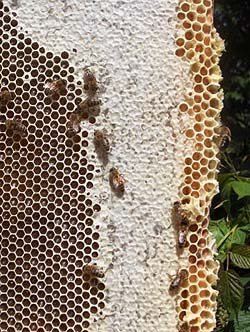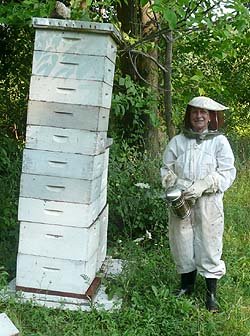Wherever you go, the land tells a story.
The early honey is darker this year. Some feel it is because the bees did not get nectar from the basswood tree flowers, which would have made the honey lighter. This is a result of weather and timing of nature. Where there are bees and pollinating insects, more fruit was set from the pollination. Much of the fruit is smaller because of the weeks of drought.

always feels like a miracle.
New Haven, Vermont July 2007
The bees made honey early this season, and then as the land and the plants dried up, the nectar also dried up for the last three or so weeks.
The leaves of the corn are curling up, to protect the plant from losing more water on the hot, sunny, dry summer days.
The arrival of the new crop always feels like a miracle. We have all sizes of northern raw honey in the honey house, and we are also shipping raw wild Maine blueberry honey, which our friends’ bees made on the blueberry barrens of northern Maine in June. This honey is darker, reminiscent of the color of wild blueberries. It is rare for the bees to make “surplus” or honey for extraction as the flowers are smaller than the bees, and they use most of the nectar for feeding their own families in the hives while in the blueberry fields for the month. The bees fill their honey comb in the lower boxes first, where they rear their brood and store food for the year. Beekeepers only take the top boxes or “supers” when they are full.
We are seeing the honey bees in Vermont and New York State strong and independent of the CCD/Colony Collapse Disorder that is killing bees elsewhere in the country. Most of the beekeeping in our region is organic, and as chemicals are not used on the bees, they are stronger and healthier. Many beekeepers in this area have been raising queen bees from their survivors, and this is one of the most effective ways to help the bees organically.
It is encouraging to see many new beekeepers throughout the land. Annemie Curlin is taking care of her first colonies of honey bees this season. I think that the bees recognized her long support of their community, as one of her hives has made the most honey in the two states and one province in this region so far this season. Annemie blessed us with the landscape drawing on the Honey Gardens’ logo/labels years ago, and is now helping with the graphics on our honey wine labels.
We appreciate your support of the bees and plants
Todd
honey bee gathering nectar & pollen from chive flower,
Annemie Curlin with her first crop,
Charlotte, Vermont, late July 2007
“My first objective was to help pollinate the fruit trees.
Also, I wanted to enrich the animal and plant cycle; by introducing honey bees, I added an additional beneficial element to the garden and nature around here.
Another thought was the aesthetic and long cultural connections; beehives are ubiquitous in Europe where I grew up, not only in the landscape, but in the folklore, the stories, and cultural consciousness… bees and bee hives.
…. and finally there was a personal connection to my grandfather Alois Schuh, who had an orchard, rose trees, and bee hives. He knew how to do all of these things, to take care of them and to make them flourish. I see the bees among my flowers; I feel that it makes my garden richer and more alive.
A lot of my other interactions with animals are adversarial; I try and protect the fruit trees from deer, the plants from insects, it can be a battle; with bees, it is mutually beneficial, I am happy to see them. We help each other; I plant flowers, which they like, they flourish and then give honey.”